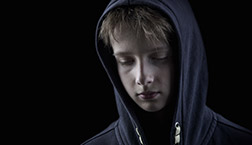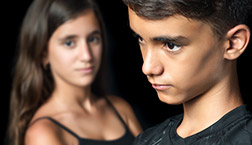Areas of Interest

Investigating the Mechanisms Linking Trauma and Adolescent Involvement in the Juvenile Justice System
The main focus of my lab's current program of research...

The Dark Triad
Attempts to better understand the cognitive, emotional, interpersonal, and psychophysiological...

Psychophysiology
A significant limitation of existing research related to JJ-involved youth is that it has relied entirely on self-report...

Girls' Delinquency
In comparison to boys involved with the juvenile justice system, girls systematically receive harsher punishments...

Intersection of Trauma, Family Systems, and Attachment
Family and caregiver attachment can often be a source of resilience in the...

Developmental Psychopathology
The traumatic, stressful and upsetting experiences of the majority of the youth involved...

Moral Injury
Moral injury is a concept that refers to negative consequences that arise when people undergo experiences that violate...
INVESTIGATING THE MECHANISMS LINKING TRAUMA AND ADOLESCENT INVOLVEMENT IN THE JUVENILE JUSTICE SYSTEM

The main focus of my lab's current program of research concerns the quest to better understand the mechanisms accounting for the link between childhood trauma and adolescent involvement in the juvenile justice system. We have received a grant from the National Institute of Justice for a 4-year (Jan 2015 – Dec 2019) longitudinal study investigating the emotional, cognitive, interpersonal, and psychophysiological mechanisms underlying the link between various forms of childhood adversity and youth's involvement in the juvenile justice system.
- Trauma and Juvenile Delinquency; Dynamic and Developmental Mechanisms
- Validation of the Five-Factor Model of PTSD Symptom Structure Among Delinquent Youth
- The Roles of Emotion Dysregulation and Dissociation in the Association Between Sexual Abuse and Self-Injury Among Juvenile Justice-Involved Youth
- Beyond Fear, Helplessness and Horror: Peritraumatic Reactions Associated With Posttraumatic Stress Symptoms Among Traumatized Delinquent Youth
- Bennett, D. C., Modrowski, C. A., Kerig, P. K., & Chaplo, S. D. (2015). Investigating the dissociative subtype of PTSD in a sample of traumatized detained youth. Psychological Trauma, 7(5), 465-472.
- Ford, J. D., Kerig, P. K., Desai, N., & Feierman, J. (in press). Psychosocial interventions for traumatized youth in the juvenile justice system: Research evidence base and clinical/legal challenges. Journal of Juvenile Justice.
- Kerig, P. K. (Ed.) (2013). Psychological trauma and juvenile delinquency: New directions in research and intervention. New York: Routledge. ISBN 978-0-415-65982-6
- Kerig, P. K., & Becker, S. P. (2010). From internalizing to externalizing: Theoretical models of the processes linking PTSD to juvenile delinquency. In S. J. Egan (Ed.), Posttraumatic stress disorder (PTSD): Causes, symptoms and treatment (pp. 33-78). Hauppauge, NY: Nova Science Publishers.
- Kerig, P. K., Becker, S. P. (2015). Early abuse and neglect as predictors of antisocial outcomes in adolescence and adulthood. In J. Morizot & L. Kazemian (Eds.), The development of criminal and antisocial behavior: Theoretical foundations and practical applications (pp. 181-199). New York: Springer. doi: 10.1007/978-3-319-08720-7_12
THE DARK TRIAD

Attempts to better understand the cognitive, emotional, interpersonal, and psychophysiological mechanisms associated with aggression have converged upon the “dark triad” of three traits: callousness, narcissism, and Machiavellianism. Our research has contributed to this work, and also has helped to shed new light on developmental pathways to the emergence of callousness that arise as a function of exposure to traumatic stress.
- Barry, C. T., Kerig, P. K., Stellwagen, K. K., & Barry, T. D. (Eds.) (2010). Narcissism and Machiavellianism in youth: Implications for the development of adaptive and maladaptive behavior. Washington, DC: American Psychological Association Press.
- Bennett, D. C., & Kerig, P. K. (2014). Investigating the construct of trauma-related acquired callousness among juvenile justice-involved youth: Differences in emotion processing. Journal of Traumatic Stress, 27(4), 415-422. doi: 10.1002/jts.21931
- Kerig, P. K., Bennett, D. C., Thompson, M., & Becker, S. P. (2012). “Nothing really matters”: Emotional numbing as a link between trauma exposure and callousness in delinquent youth. Journal of Traumatic Stress, 25, 1–8. doi: 10.1002/jts.21700
- Kerig, P. K., & Sink, H. E. (2010). The new scoundrel on the schoolyard: Contributions of Machiavellianism to the understanding of youth aggression. In C. T. Barry, P. K. Kerig, K. K. Stellwagen, & T. D. Barry (Eds.), Narcissism and Machiavellianism in youth: Implications for the development of adaptive and maladaptive behavior (pp. 193-212). Washington, DC: American Psychological Association Press.
- Stellwagen, K. K., & Kerig, P. K. (2013). Ringleader bullying: Association with psychopathic narcissism and theory of mind among child psychiatric inpatients. Child Psychiatry & Human Development, 44(5), 612-620. doi: 10.1007/s10578-012-0355-5
- Stellwagen, K. K., & Kerig, P. K. (2013). Dark triad personality traits and theory of mind among school-age children. Personality and Individual Differences, 54(1), 123–127. doi:10.1016/j.paid.2012.08.019
- Stellwagen, K. K., Kerig, P. K., & Barry, C. T. (2010). The developmental psychopathology of narcissism and Machiavellianism. In C. T. Barry, P. K. Kerig, K. K. Stellwagen, & T. D. Barry (Eds.), Narcissism and Machiavellianism in youth: Implications for the development of adaptive and maladaptive behavior (pp. 3-8). Washington, DC: American Psychological Association Press.
PSYCHOPHYSIOLOGY

A significant limitation of existing research related to JJ-involved youth is that it has relied entirely on self-report. Discrepancies commonly are found between self-report and physiological measures of emotion regulation. Not only may JJ-involved youth be motivated to deny emotional arousal to present a “tough-guy” facade and to defend against further victimization but youth who engage in experiential avoidance may be particularly poor reporters about their own emotional responses. Moreover, leading theorists increasingly emphasize the importance of understanding psychophysiological systems underlying the trauma response in that these may represent sources of not only risk but of resilience for victimized youth.
GIRLS' DELINQUENCY

In comparison to boys involved with the juvenile justice system, girls systematically receive harsher punishments than boys. Gender differences in how boys and girls experience stress and how they behave in response to the same emotions may also affect female rates of delinquency. In comparison to boys, Research has shown that girls in the JJ system may experience more conflict and adversity in their family relationships, experience particularly troubled relationships with mothers and that these factors may predict girls delinquency and aggression.
Overall, girls in the JJ system have more severe mental health issues, have experienced more significant childhood adversity, particularly sexual trauma, and receive disproportionate sanctions for low-level forms of antisocial behavior, such as status offenses and provocative sexual behavior. These risk factors also appear to be dynamically interrelated, with trauma and family adversity increasing the likelihood that girls will act out or engage in risky behaviors that, in turn, lead to involvement in the JJ system. However, these factors also are found to contribute to boys delinquency, as well, and therefore, further research is needed to explore if the pathway to delinquency for girls is in fact “unique”.
- Engendering the Evidence Base: Critical Review of the Empirical and Conceptual Foundations of Gender-Responsive Interventions for Girls Delinquency
- Trauma among girls in the juvenile justice system
- For Better or Worse; Intimate Relationship as Sources of Risk or Resilience for Girls Delinquency
INTERSECTION OF TRAUMA, FAMILY SYSTEMS, AND ATTACHMENT

Family and caregiver attachment can often be a source of resilience in the aftermath of trauma. Youth exposed to family violence may develop increased aggression, and emotional numbing has been found to be prevalent among youth in at-risk families. Low family involvement may be a risk factor for further delinquency and negative mental health outcomes. It is important to examine caregiver roles and family systems among JJ-involved youth, as they provide a clarifying role into factors of risk or resilience.
- Family Matters: Integrating Treatment into Functional Family Therapy for Traumatized Delinquent Youth
- Early abuse and neglect as risk factors for the development of criminal and antisocial behavior
- Introduction to the special issues: Attachment-based treatments for adolescents
DEVELOPMENTAL PSYCHOPATHOLOGY

The traumatic, stressful and upsetting experiences of the majority of the youth involved in the JJ system are characterized not by any single form of violence, but rather polyvictimization. Polyvictimization among JJ-involved youth typically does not involve discrete events, but rather chronic, repeated victimization experiences, which have the most severe effects on the development of young people.
Common childhood mental health problems that can affect JJ-involved youth include externalizing (conduct problems, inattention-hyperactivity, and peer problems) and internalizing (emotional problems) issues. Theory suggests that traumatized youth are not inherent callous but rather actively use emotional numbing and experiential avoidance to cope with traumatic or unpleasant events and experiences. We hope to advance our understanding of both psychopathology and resilience among JJ-involved youth with our research.
MORAL INJURY

Moral injury is a concept that refers to negative consequences that arise when people undergo experiences that violate their deeply held moral beliefs. Moral injury is also related to the concept of perpetration-induced trauma, which proposes that traumatic stress reactions can follow from experiences in which one is the perpetrator of harm against another—whether through an action was intentionally committed, was compelled to commit, witnessed, or failed to perform. Although these concepts arose in the context of the study of adults in extreme experiences, such as soldiers in a time of war, or individuals involved in performing executions, we recognized that interpersonal harm comes in all shapes and sizes, and occurs at all ages. Even children and adolescents may undergo experiences that cause them to question their beliefs about themselves and the world around them. To this end, we have engaged in a number of studies exploring these concepts in samples of children, adolescents, and emerging adults, including former child soldiers in international contexts and youth gang members in the US.
- Kerig, P. K., Chaplo, S. D., Bennett, D. C., & Modrowski, C. (in press). Harm as harm: Gang membership, perpetration trauma, and posttraumatic stress symptoms among youth in the juvenile justice system. Criminal Justice and Behavior.
- Kerig, P. K., & Wainryb, C. (2013). Interventions to promote reintegration of traumatized youth conscripted as child soldiers. Journal of Aggression, Maltreatment, and Trauma, 22(8), 1-6. doi: 10.1080/10926771.2013.823591
- Kerig, P. K. & Wainryb, C. (Eds.). (2014). Trauma and resilience among former child soldiers around the world. New York: Routledge. ISBN 13: 978-0-415-73543-8
- Kerig, P. K., & Wainryb, C., Twali, M. S., & Chaplo, S. D. (2013). America’s child soldiers: Toward a research agenda for studying gang-involved youth in the US. Journal of Aggression, Maltreatment, and Trauma, 22(7), 1-23. doi: 10.1080/10926771.2013.813883
- Wainryb, C. & Kerig, P. K. (2013). The person and the societal context: Future directions for research on the traumatic effects of child soldiering around the world. Journal of Aggression, Maltreatment, and Trauma, 22(8), 1-9. doi: 10.1080/10926771.2013.823592